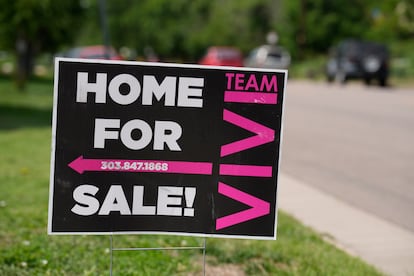Home sales in June fell to the slowest pace since January with near-historic low inventory for sale
The national median sales price fell on an annual basis for the fifth month in a row, though fierce competition led to about one-third of homes selling for more than their list price

Sales of previously occupied U.S. homes fell in June to the slowest pace since January, as a near-historic low number of homes for sale and rising mortgage rates kept many would-be homebuyers on the sidelines. The national median sales price fell on an annual basis for the fifth month in a row, though fierce competition led to about one-third of homes selling for more than their list price.
Existing home sales fell 3.3% last month from May to a seasonally adjusted annual rate of 4.16 million, the National Association of Realtors said Thursday. That’s slightly below what economists were expecting, according to FactSet, and marks the slowest sales pace since January.
Sales sank 18.9% compared with June last year. All told, sales are down 23% through the first half of this year.
The national median sales price fell 0.9% from June last year to $410,200. That’s the smallest annual decline since March. While down from a year earlier, the median sales price rose from the previous month, reaching the second-highest level on records going back to January 1999.
“Perhaps home prices are beginning to firm up or at least certainly any downward pressure is ending,” said Lawrence Yun, the NAR’s chief economist.
The latest housing market figures are more evidence that even with prices easing back on an annual basis after rising for more than a decade many house hunters are being held back by a persistently low inventory of homes for sale.
Some 1.08 million homes remained on the market by the end of June, down 13.6% from a year earlier, the NAR said. That amounts to a 3.1-month supply at the current sales pace. In a more balanced market between buyers and sellers, there is a 5- to 6-month supply.
The shortage of homes for sale has kept the market competitive, driving bidding wars in many places, especially for the most affordable homes. About one-third of homes purchased last month sold for above their list price, and 76% of homes sold in June were on the market for less than a month.
“This is a tough market to be a buyer,” Yun said.
The combination of high borrowing costs and intense competition for the most affordable homes on the market is shutting out many first-time buyers. They accounted for 27% of home sales last month, down from 28% in May and 30% in June last year, the NAR said. In a normal housing market, that would be 40%.
The U.S. housing market has yet to emerge from a slump that started a little more than a year ago, when the average rate on a 30-year mortgage began to climb from ultra-low levels as the Federal Reserve began raising its short-term rate in its fight against inflation.
Global demand for U.S. Treasurys, which lenders use as a guide to pricing loans, investors’ expectations for future inflation and what the Fed does with interest rates influence rates on home loans.
The average rate on a 30-year home loan is still more than double what it was two years ago, when the ultra-low rates spurred a wave of home sales and refinancing. Weekly average rates on a 30-year mortgage ranged between 6.67% and 6.79% in June, according to mortgage buyer Freddie Mac. This week, the average rate slipped to 6.78%, the lowest level in four weeks. A year ago, the rate averaged 5.54%.
Higher mortgage rates can add hundreds of dollars a month in costs for homebuyers on top of already high home prices. They also discourage homeowners who locked in those low rates two years ago from selling -- one reason the supply of homes for sale has been low even during the traditionally busy spring homebuying season.
Sign up for our weekly newsletter to get more English-language news coverage from EL PAÍS USA Edition
Tu suscripción se está usando en otro dispositivo
¿Quieres añadir otro usuario a tu suscripción?
Si continúas leyendo en este dispositivo, no se podrá leer en el otro.
FlechaTu suscripción se está usando en otro dispositivo y solo puedes acceder a EL PAÍS desde un dispositivo a la vez.
Si quieres compartir tu cuenta, cambia tu suscripción a la modalidad Premium, así podrás añadir otro usuario. Cada uno accederá con su propia cuenta de email, lo que os permitirá personalizar vuestra experiencia en EL PAÍS.
¿Tienes una suscripción de empresa? Accede aquí para contratar más cuentas.
En el caso de no saber quién está usando tu cuenta, te recomendamos cambiar tu contraseña aquí.
Si decides continuar compartiendo tu cuenta, este mensaje se mostrará en tu dispositivo y en el de la otra persona que está usando tu cuenta de forma indefinida, afectando a tu experiencia de lectura. Puedes consultar aquí los términos y condiciones de la suscripción digital.
More information
Archived In
Últimas noticias
Most viewed
- Sinaloa Cartel war is taking its toll on Los Chapitos
- Oona Chaplin: ‘I told James Cameron that I was living in a treehouse and starting a permaculture project with a friend’
- Reinhard Genzel, Nobel laureate in physics: ‘One-minute videos will never give you the truth’
- Why the price of coffee has skyrocketed: from Brazilian plantations to specialty coffee houses
- Silver prices are going crazy: This is what’s fueling the rally










































